Abstract
The effect of neonatally initiated injections of anti-mu rabbit antiserum on immunity of rats against Trypanosoma cruzi infection was investigated in vivo. Anti-mu treatment resulted in a loss of immunoglobulin M (IgM) and IgG2a synthesis and, subsequently, of antibody production. These rats so treated were shown to be significantly more susceptible to the acute phase of the infection than the control rats treated with normal rabbit serum, as measured by increased parasitemia and mortality. These results indicate the essential role of antibodies, probably in association with complement or effector cells or both, in immunity to acute Chagas' disease.
Full text
PDF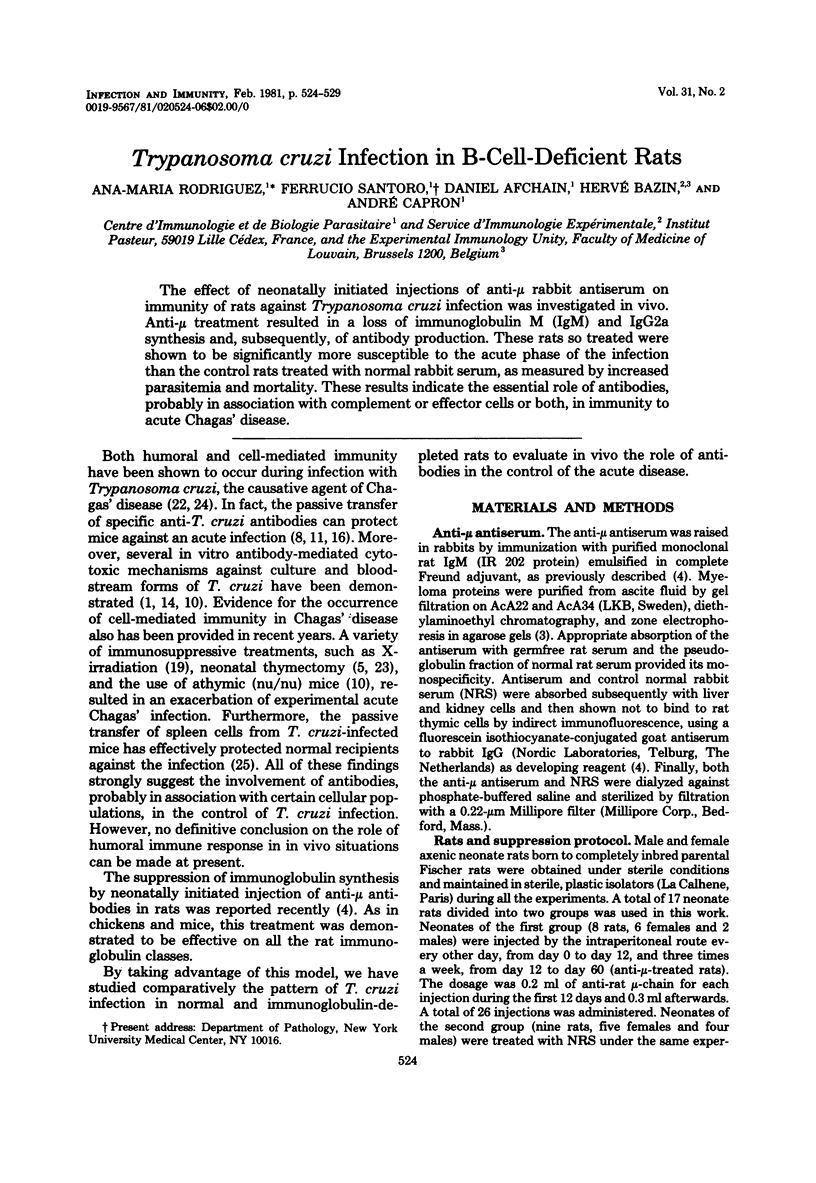
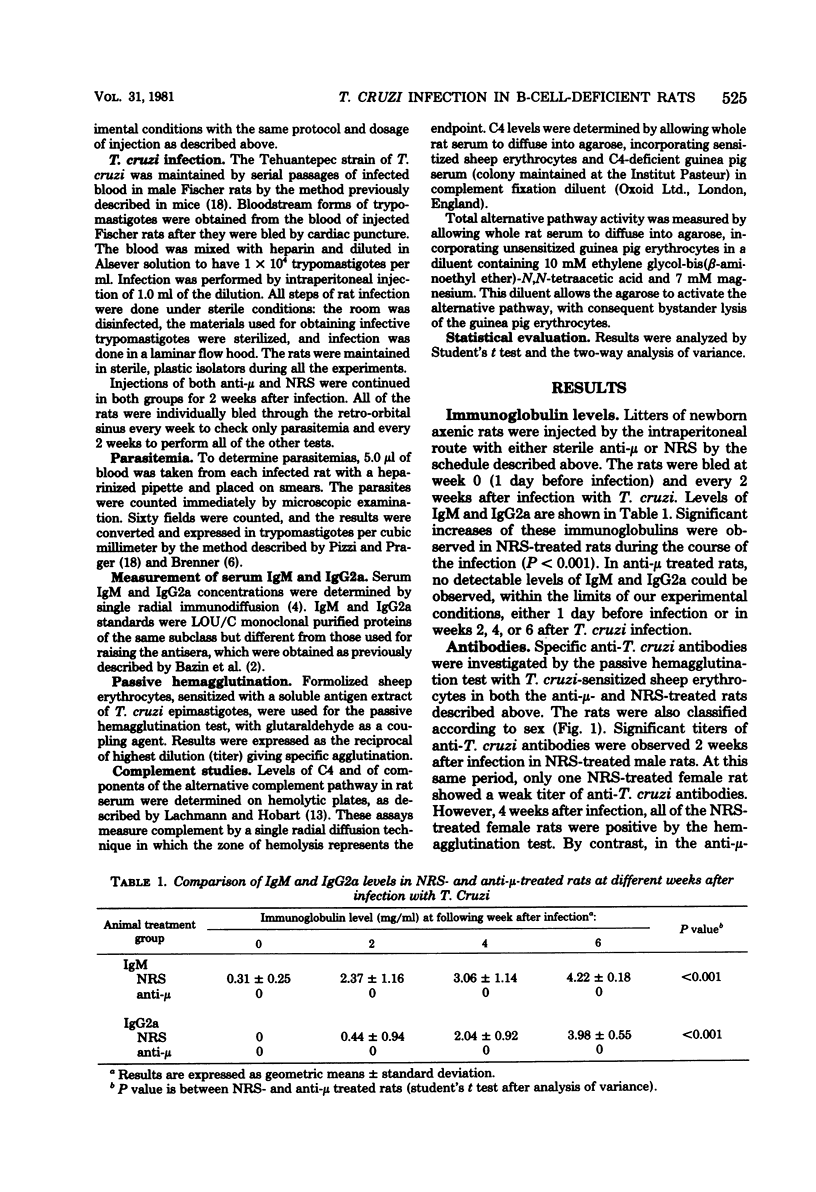
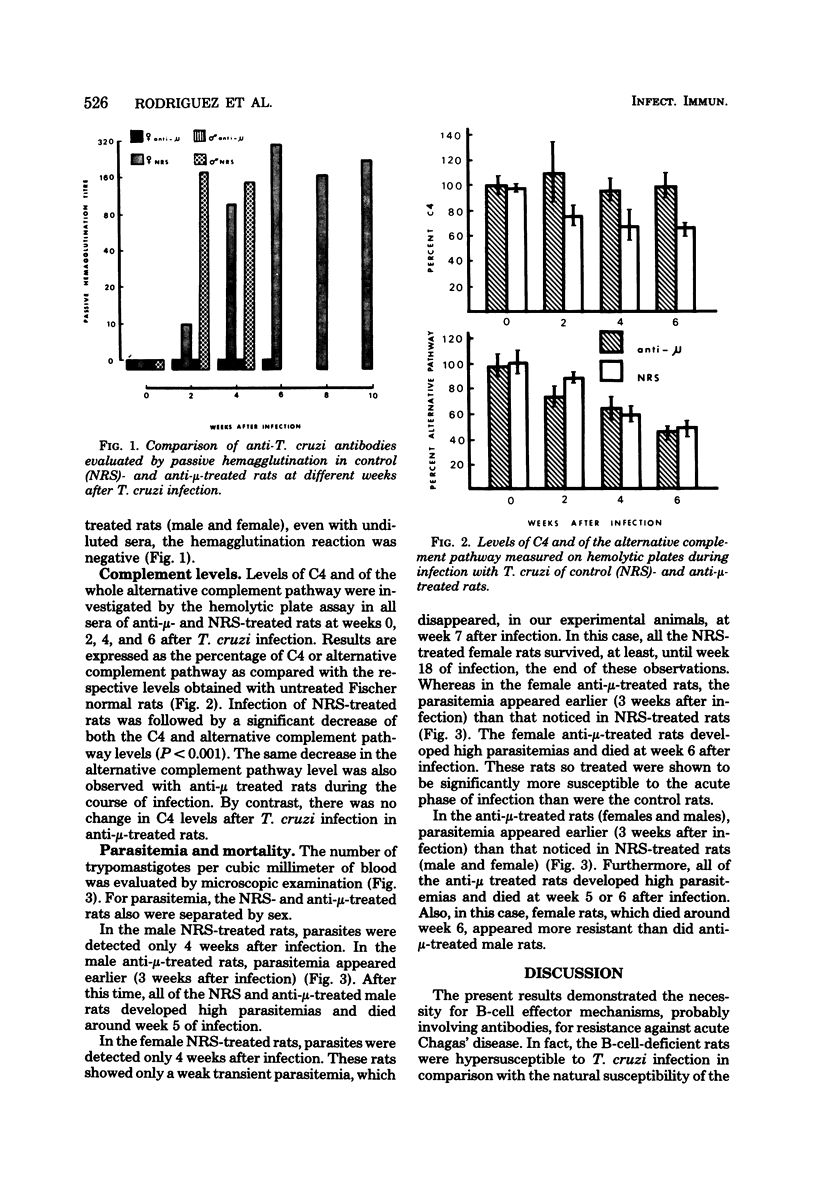
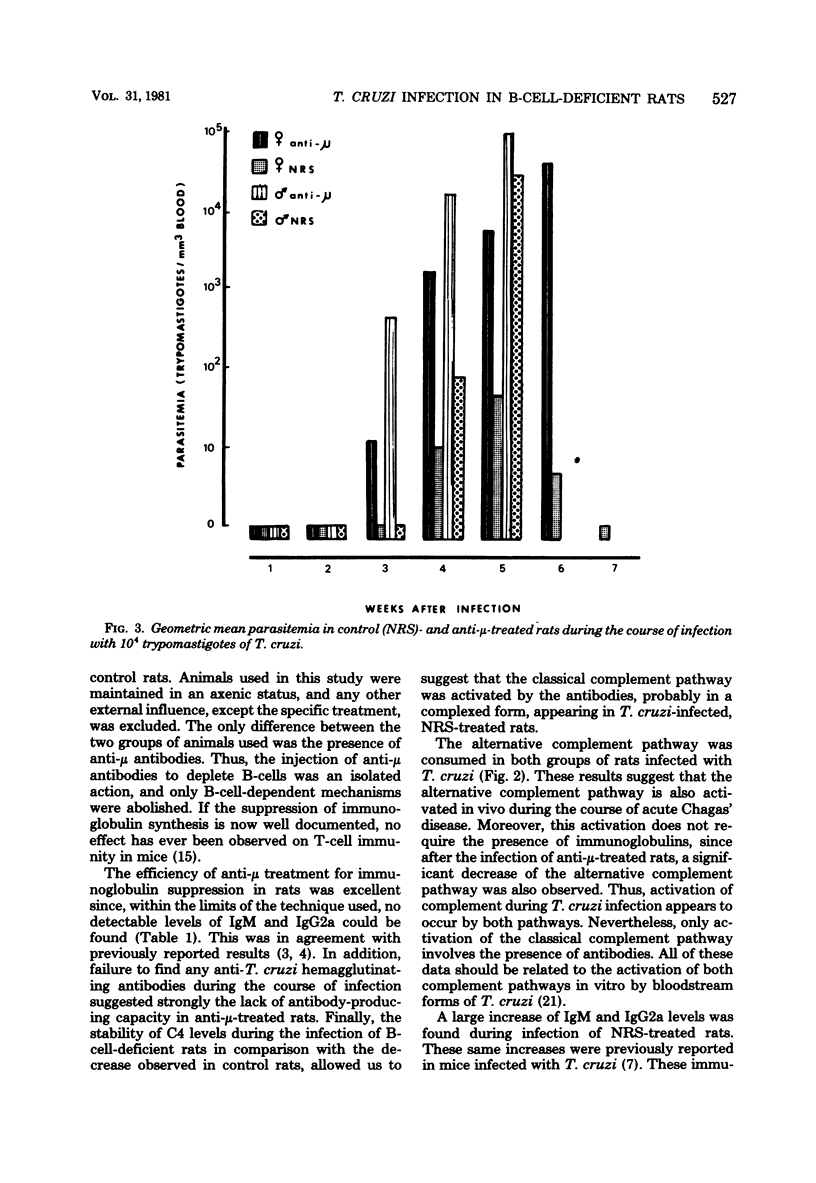
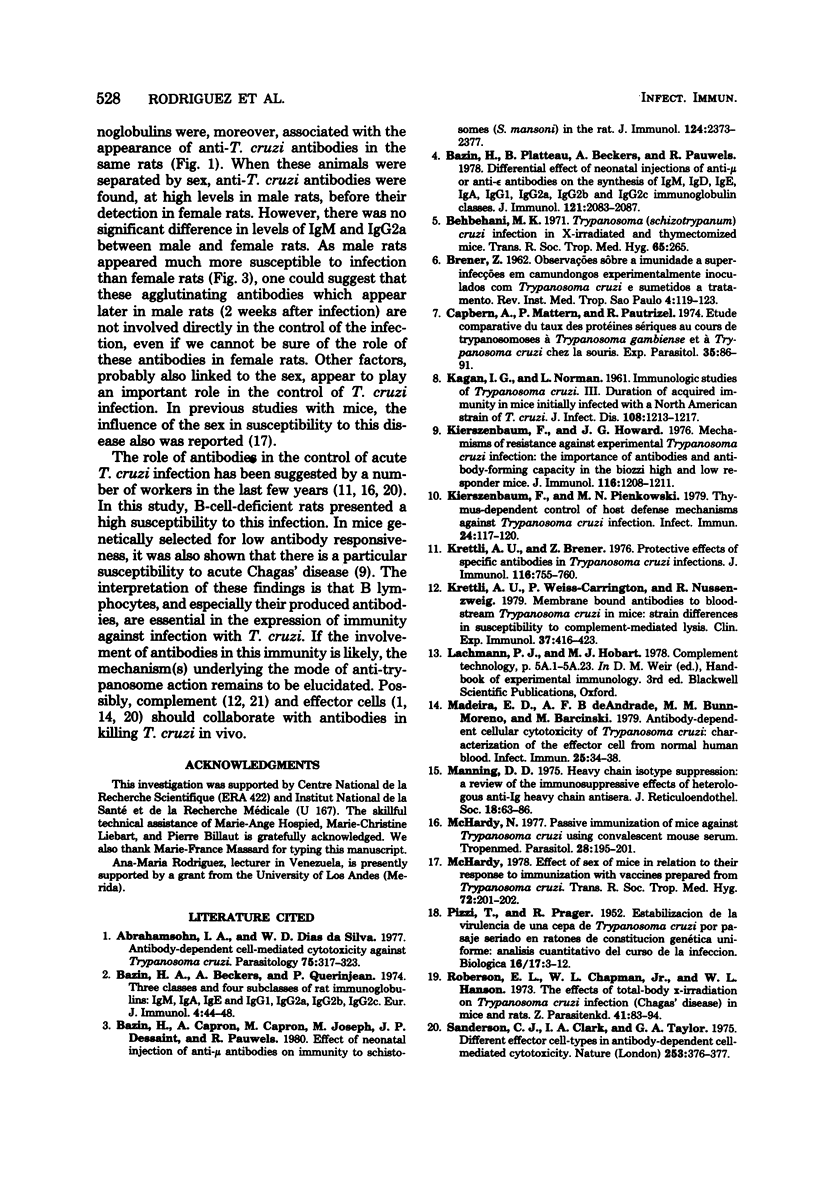
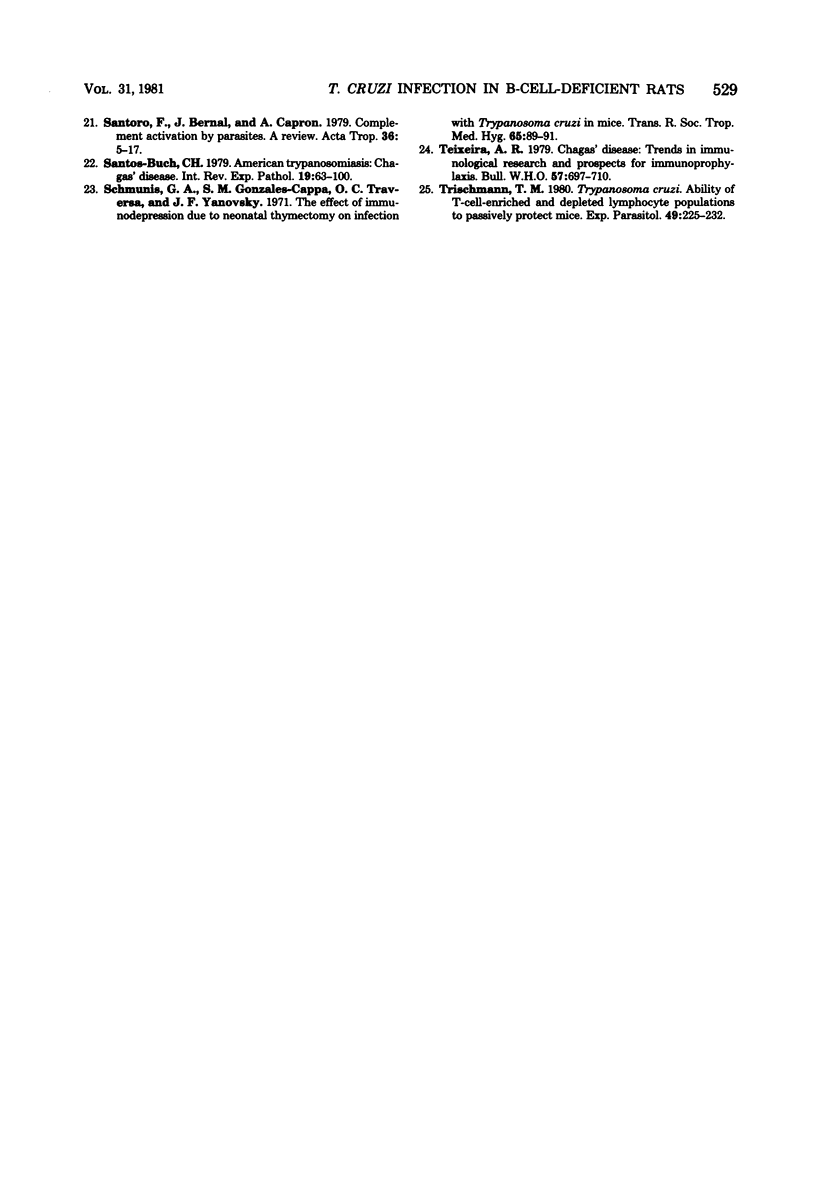
Selected References
These references are in PubMed. This may not be the complete list of references from this article.
- Abrahamsohn I. A., Silva W. D. Antibody dependent cell-mediated cytotoxicity against Trypanosoma cruzi. Parasitology. 1977 Dec;75(3):317–323. doi: 10.1017/s0031182000051866. [DOI] [PubMed] [Google Scholar]
- BRENER Z. [Observations on immunity to superinfections in mice experimentally inoculated with Trypanosoma cruzi and subjected to treatment]. Rev Inst Med Trop Sao Paulo. 1962 Mar-Apr;4:119–123. [PubMed] [Google Scholar]
- Bazin H., Beckers A., Querinjean P. Three classes and four (sub)classes of rat immunoglobulins: IgM, IgA, IgE and IgG1, IgG2a, IgG2b, IgG2c. Eur J Immunol. 1974 Jan;4(1):44–48. doi: 10.1002/eji.1830040112. [DOI] [PubMed] [Google Scholar]
- Bazin H., Capron A., Capron M., Joseph M., Dessaint J. P., Pauwels R. Effect of neonatal injection of anti-mu antibodies on immunity to schistosomes (S. mansoni) in the rat. J Immunol. 1980 May;124(5):2373–2377. [PubMed] [Google Scholar]
- Bazin H., Platteau B., Beckers A., Pauwels R. Differential effect of neonatal injections of anti-mu or anti-delta antibodies on the synthesis of IgM, IgD, IgE, IgA, IgG1, IgG2a, IgG2b, and IgG2c immunoglobulin classes. J Immunol. 1978 Nov;121(5):2083–2087. [PubMed] [Google Scholar]
- Capbern A., Mattern P., Pautrizel R. Etude comparative du taux des protéines sériques au cours de trypanosomoses à Trypanosoma gambiense et à Trypanosoma cruzi chez la souris. Exp Parasitol. 1974 Feb;35(1):86–91. doi: 10.1016/0014-4894(74)90010-1. [DOI] [PubMed] [Google Scholar]
- Kierszenbaum F., Howard J. G. Mechanisms of resistance against experimental Trypanosoma cruzi infection: the importance of antibodies and antibody-forming capacity in the Biozzi high and low responder mice. J Immunol. 1976 May;116(5):1208–1211. [PubMed] [Google Scholar]
- Kierszenbaum F., Pienkowski M. M. Thymus-dependent control of host defense mechanisms against Trypanosoma cruzi infection. Infect Immun. 1979 Apr;24(1):117–120. doi: 10.1128/iai.24.1.117-120.1979. [DOI] [PMC free article] [PubMed] [Google Scholar]
- Krettli A. U., Brener Z. Protective effects of specific antibodies in Trypanosoma cruzi infections. J Immunol. 1976 Mar;116(3):755–760. [PubMed] [Google Scholar]
- Krettli A. U., Weisz-Carrington P., Nussenzweig R. S. Membrane-bound antibodies to bloodstream Trypanosoma cruzi in mice: strain differences in susceptibility to complement-mediated lysis. Clin Exp Immunol. 1979 Sep;37(3):416–423. [PMC free article] [PubMed] [Google Scholar]
- Madeira E. D., de Andrade A. F., Bunn-Moreno M. M., Barcinski M. Antibody-dependent cellular cytotoxicity of Trypanosoma cruzi: characterization of the effector cell from normal human blood. Infect Immun. 1979 Jul;25(1):34–38. doi: 10.1128/iai.25.1.34-38.1979. [DOI] [PMC free article] [PubMed] [Google Scholar]
- Manning D. D. Heavy chain isotype suppression: a review of the immunosuppressive effects of heterologous anti-Ig heavy chain antisera. J Reticuloendothel Soc. 1975 Jul;18(1):63–86. [PubMed] [Google Scholar]
- McHardy N. Effect of sex of mice in relation to their response to immunization with vaccines prepared from Trypanosoma cruzi. Trans R Soc Trop Med Hyg. 1978;72(2):201–202. doi: 10.1016/0035-9203(78)90064-0. [DOI] [PubMed] [Google Scholar]
- McHardy N. Passive immunization of mice against Trypanosoma cruzi using convalescent mouse serum. Tropenmed Parasitol. 1977 Jun;28(2):195–201. [PubMed] [Google Scholar]
- Roberson E. L., Chapman W. L., Jr, Hanson W. L. The effects of total-body x-irradiation on Trypanosoma cruzi infection (Chagas' disease) in mice and rats. Z Parasitenkd. 1973 Apr 24;41(2):83–94. doi: 10.1007/BF00328752. [DOI] [PubMed] [Google Scholar]
- Sanderson C. J., Clark I. A., Taylor G. A. Different effector cell types in antibody-dependent cell-mediated cytotoxicity. Nature. 1975 Jan 31;253(5490):376–377. doi: 10.1038/253376a0. [DOI] [PubMed] [Google Scholar]
- Santoro F., Bernal J., Capron A. Complement activation by parasites. A review. Acta Trop. 1979 Mar;36(1):5–14. [PubMed] [Google Scholar]
- Santos-Buch C. A. American trypanosomiasis: Chagas' disease. Int Rev Exp Pathol. 1979;19:63–100. [PubMed] [Google Scholar]
- Teixeira A. R. Chagas' disease: trends in immunological research and prospects for immunoprophylaxis. Bull World Health Organ. 1979;57(5):697–710. [PMC free article] [PubMed] [Google Scholar]
- Trischmann T. M., Bloom B. R. Trypanosoma cruzi: ability of T-cell-enriched and -depleted lymphocyte populations to passively protect mice. Exp Parasitol. 1980 Apr;49(2):225–232. doi: 10.1016/0014-4894(80)90119-8. [DOI] [PubMed] [Google Scholar]


